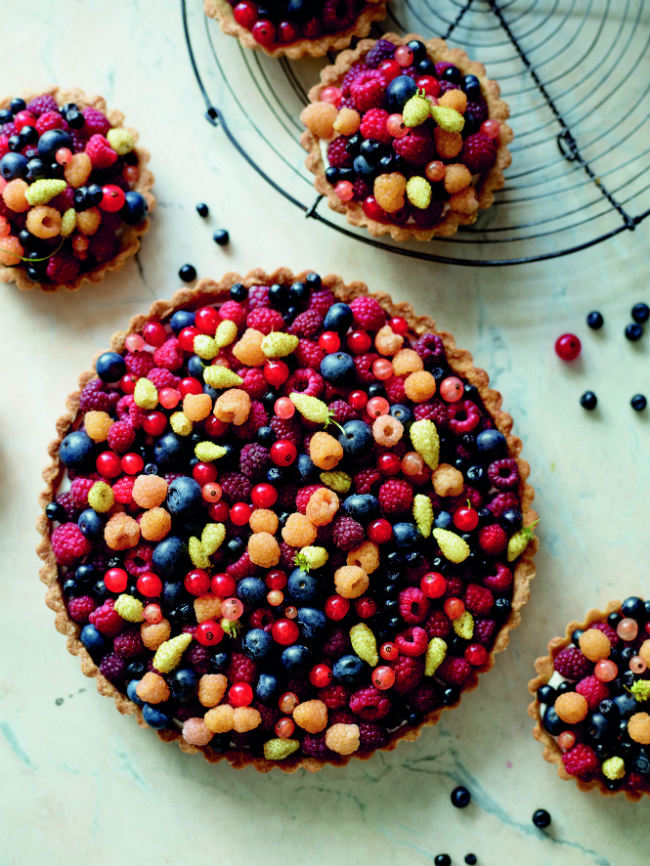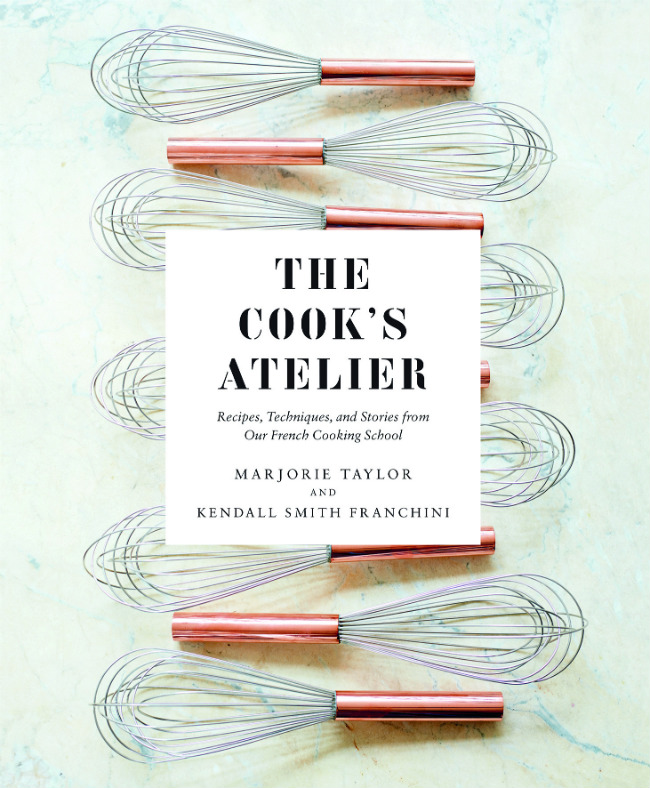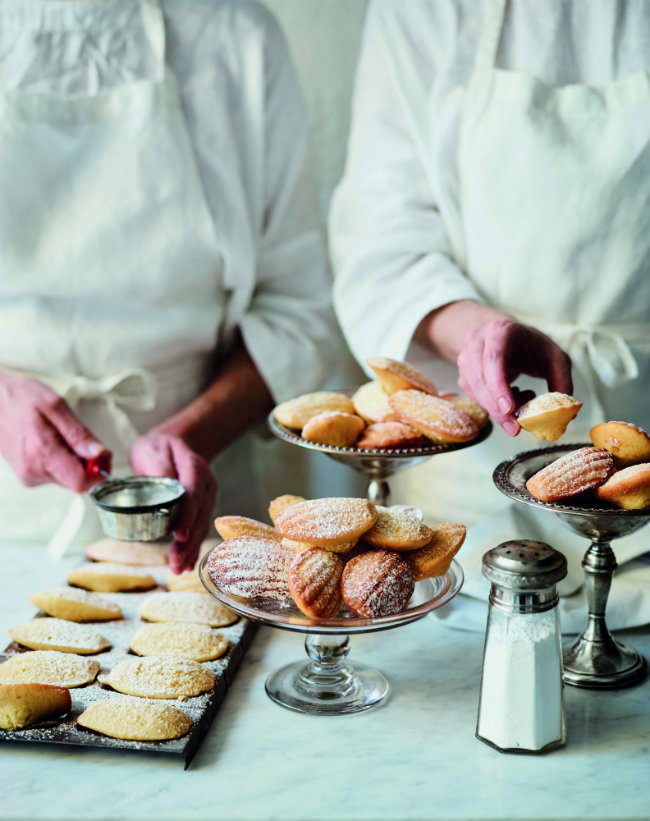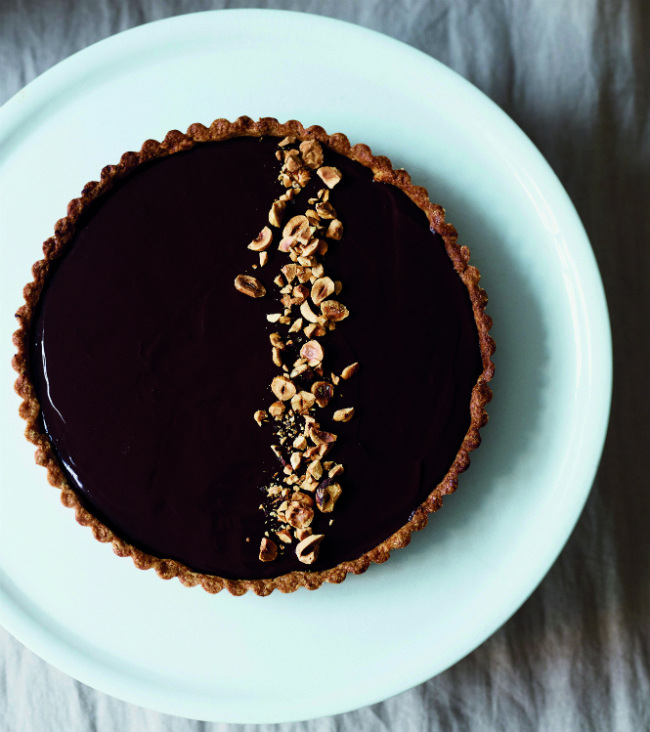Recipes from The Cook’s Atelier in Beaune, Burgundy

The mother-daughter team behind The Cook’s Atelier, Marjorie Taylor and Kendall Smith Franchini, share some tasty treats from their French cooking school– located in Beaune in the heart of Burgundy. These lovely recipes are excerpted with permission by the publisher, Abrams New York. Photography © Anson Smart 2018. Purchase the book on Amazon below:
SUMMER BERRY TART
Makes 1 (9in/23cm) tart or 8 (4in/10cm) tartlets
When making this fresh fruit tart or tartlets, we use a colourful array of summer berries. Look for fresh, seasonal berries at your local market, but don’t forget to make the pastry cream in advance, as it needs to set for about two hours in the refrigerator.
INGREDIENTS
Unbleached all-purpose flour, for dusting
1⁄2 recipe for pâte sablée (see below)
1 large egg yolk
1⁄2 cup (120ml) plus 3 tablespoons double cream
1 tablespoon confectioners’ sugar
1 recipe crème pâtissière (see below)
1 cup (145g) fresh blueberries
1 cup (125g) fresh yellow raspberries
1 cup (125g) fresh red raspberries
1⁄2 cup (82g) fresh red currants
1⁄2 cup (82g) fresh white or pink currants
1⁄4 cup (35g) hulled fresh white woodland strawberries or tiny strawberries
1 On a lightly floured surface, use the pâte sablée to make the tart shell. Freeze it for 15 to 20 minutes before baking.
2 Preheat the oven to 375°F (190°C).
3 In a small bowl, whisk together the egg yolk and 3 tablespoons of the double cream. Use a pastry brush to lightly brush the egg wash over the dough. Blind bake the tart shell.
4 In a large bowl, combine the remaining 1⁄2 cup (120ml) heavy cream and the confectioners’ sugar, then use a balloon whisk to beat them until soft peaks form. Add a spoonful of the whipped cream to the pastry cream and stir to lighten it.
5 Using an offset spatula or small knife, spread the pastry cream in the cooled tart shell. Top it with the fruit and serve immediately with the whipped cream alongside.

Summer berry tart. The Cook’s Atelier, by Marjorie Taylor and Kendall Smith Franchini. Photography © Anson Smart 2018.
PÂTE SABLÉE
Makes enough for 2 (9inch/23cm) tarts or 16 (4inch/10cm) tartlets
INGREDIENTS
3 1⁄2 cups (440g) unbleached all-purpose flour, plus extra for kneading
1 cup (125g) sifted confectioners’ sugar
1 teaspoon fleur de sel
2 cups (4 sticks/450g) unsalted butter, cut into small pieces and softened slightly
3 large egg yolks
3 tablespoons double cream
1 In a large bowl, whisk together the our, sugar, and salt. Add the butter. Using your hands, gently toss to coat the butter in the our mixture. Scoop the mix into your hands and gently press the our butter between your fingertips until it looks grainy, with some small pieces of butter still visible. Work quickly to ensure the butter stays cold.
2 In a small bowl, lightly beat the egg yolks and cream. Drizzle over the dough and use a fork to gently toss until incorporated. Continue working the dough, gently squeezing it between your fingertips until it comes together and there is no dry our visible. Be careful not to overwork the dough. It’s ready as soon as you can squish it in one hand and it stays together.
3 On a lightly floured and cool work surface, knead the dough until it is completely smooth.
4 Divide it in half and shape each piece into a disk. Wrap them in cling film and refrigerate for at least one hour, or preferably overnight. Pâte sablée can be wrapped in a double layer of cling film and refrigerated for up to two days or frozen for up to two months.

The Cook’s Atelier, by Marjorie Taylor and Kendall Smith Franchini. Photography © Anson Smart 2018.
CRÈME PÂTISSIÈRE
Makes about 1 1⁄4 cups (300ml)
INGREDIENTS
2 cups (480 ml) whole milk
1⁄2 cup (100 g) sugar
1 vanilla bean pod, seeds removed
5 large egg yolks
3 tablespoons unbleached all-purpose flour
1 tablespoon unsalted butter
1 In a medium saucepan, heat the milk, all but 1 tablespoon of the sugar, and the vanilla seeds and pod over medium heat until the sugar has dissolved and the milk is just about to boil.
2 In a medium bowl, combine the egg yolks and remaining tablespoon of sugar and whisk until thick and pale yellow. Sift the flour over the yolks and whisk to combine.
3 Very slowly, add the warm milk mixture to the eggs, whisking continuously. Pour the mix back into the saucepan over medium heat. Cook, whisking continuously until it thickens and comes to the boil, for about two minutes.
4 Push the pastry cream through a fine-mesh strainer into a large bowl; discard the vanilla pod. Whisk in the butter. Press cling film against the pastry cream’s surface to prevent a skin forming.
5 Let it cool slightly, then refrigerate until chilled and set, for about two hours. Pastry cream can be used once chilled or stored in the refrigerator for up to three days.

Madeleines. The Cook’s Atelier, by Marjorie Taylor and Kendall Smith Franchini. Photography © Anson Smart 2018.
MADELEINES
Makes about 36 madeleines
These small, buttery cakes, forever associated with the French writer Marcel Proust, are baked in fluted tins, giving them their unforgettable shell-like shape – one of the true sweet representations of France. Baked in a hot oven, they puff up to create the classic “hump” on their backs. We serve them warm with coffee after every class at The Cook’s Atelier.
INGREDIENTS
2⁄3 cup (150g) unsalted butter
1 tablespoon lemon zest
1 tablespoon fresh lemon juice
3 large eggs, at room temperature
1 large egg yolk, at room temperature
3⁄4 cup (150g) granulated sugar
1⁄2 teaspoon fleur de sel
1 1⁄2 cups (190g) unbleached all-purpose flour, plus more for the pans
1 teaspoon baking powder
Confectioners’ sugar, for dusting
1 In a small saucepan, melt the butter over a low heat. Let it cool slightly, then use a pastry brush to generously coat two or three madeleine tins with butter. Dust the pans with our, tapping out any excess, and refrigerate to set.
2 Add the lemon zest and lemon juice to the remaining butter and set aside.
3 In the bowl of a stand mixer fitted with a whisk attachment, combine the eggs, egg yolk, sugar and salt. Beat on medium-high speed until the mixture is pale and has doubled in volume, this takes about five minutes. The batter should have a ribbon-like consistency when dripped from the whisk.
4 Sift the flour and baking powder into the egg mixture and use a large rubber spatula to gently fold until just combined. Slowly drizzle the melted butter into the batter, folding gently until fully incorporated. Cover and refrigerate for at least 1 1⁄2 hours or up to 12.
5 Set a rack in the upper third of the oven and preheat to 375°F (190°C).
6 Place the madeleine batter in a pastry bag fitted with a large round tip. Starting near the “base”, pipe into the bottom of each mould, filling them about two-thirds of the way up and not spreading the batter. Bake until the madeleines feel set to the touch, seven to eight minutes should do it. Let them cool slightly, dust with confectioners’ sugar, then serve immediately. Madeleines are best served warm and eaten the day they are made.

Chocolate hazelnut tart. Madeleines. The Cook’s Atelier, by Marjorie Taylor and Kendall Smith Franchini. Photography © Anson Smart 2018.
CHOCOLATE HAZELNUT TART
Makes 1 (9in/23cm) tart or 8 (4in/10cm) tartlets
We generally save chocolate desserts for the colder months, and we especially like this tart because it’s decadent, without being too sweet. Use the best-quality chocolate you can find, ideally with at least 70 per cent cacao. You can make this recipe with a classic pâte sucrée, though we love adding ground hazelnuts to the dough for added flavour.
INGREDIENTS
Unbleached all-purpose flour, for dusting
1⁄2 recipe for pâte sucrée (see below), nut dough variation
1 large egg yolk
1 1⁄2 cups plus 3 tablespoons (405ml) double cream
12 oz (340g) high-quality bittersweet chocolate (at least 70% cacao), finely chopped
3⁄4 cup (100g) hazelnuts, toasted, skinned and coarsely chopped
1 Preheat the oven to 375°F (190°C).
2 On a lightly floured surface, use the pâte sucrée to make the tart shell. Freeze it for 15 to 20 minutes before baking.
3 In a small bowl, whisk together the egg yolk and cream. Lightly brush the egg wash over the tart shell, blind bake it (see instructions below), then leave to cool.
4 To make the ganache, place the chocolate in a large heatproof bowl. In a small saucepan, heat the remaining 1 1⁄2 cups (360ml) of cream over a medium heat until it’s just under the boil. Pour over the chocolate, then gently stir with a rubber spatula until the chocolate is melted and smooth.
5 Pour the ganache into the cooled tart shell and use an offset spatula to spread it evenly. Top with toasted hazelnuts. Let the tart stand in a cool, dry place (don’t refrigerate) until set, then serve. This tart is best eaten the day it is made.
PÂTE SUCRÉE
Makes enough for 2 (9in/23cm) tarts or 16 (4in/10cm) tartlets
INGREDIENTS
3 cups (375g) unbleached all-purpose flour
1⁄2 cup (100g) sugar
1⁄2 teaspoon fleur de sel
1 cup (2 sticks/225g) cold unsalted butter, cut into small pieces
2 large egg yolks
1⁄3 cup (80ml) double cream
1 In a large bowl, whisk together the flour, sugar, and salt. Add the butter. Using your hands, gently toss to coat the butter in the our mixture. Scoop the mix in your hands and gently press between your fingertips until it looks grainy, with some small pieces of butter still visible. Work quickly to ensure the butter stays cold.
2 In a small bowl, lightly beat the egg yolks and cream. Drizzle over the dough and use a fork to gently toss until incorporated. Continue working the dough, gently squeezing it between your fingertips until it comes together and there is no dry our visible. Be careful not to overwork the dough. It’s ready as soon as you can squish it in one hand and it stays together.
3 Divide the dough in half and shape each piece into a disk. Wrap these in cling film and refrigerate for at least an hour, or preferably overnight. Pâte sucrée can be wrapped in a double layer of cling film and refrigerated for up to two days or frozen for up to two months. Variations: For a nut dough, replace 1⁄2 cup (65g) of the flour with 1⁄2 cup (55g) finely chopped toasted skinned hazelnuts or almonds. For a citrus dough, add 2 to 3 teaspoons of finely grated lemon or orange zest to the flour, sugar, and salt mixture.
BLIND BAKING
This is baking a tart crust partially or completely before adding the filling. Chilled tarts, such as the summer berry tart with pastry cream filling, should be fully baked before filling. Baked fruit or savoury tarts need to be partially baked before adding the filling, and then returned to the oven to finish baking.
1 Preheat the oven to 375°F (190°C).
2 To fully blind bake a tart or tartlets, take the chilled, unbaked crust, shaped in a tart pan, and place on a baking sheet. Cut a parchment paper circle slightly larger than the circumference of the tart or tartlets (leaving 1 in/2.5cm overhang) and place inside. Fill the lined tart shell with pie weights or dried beans to the top of the pan.
3 Cook the tart crust for 15 to 20 minutes (eight to 10 minutes for tartlets), or until the edges are set and beginning to turn golden. Remove the parchment and beans or pie weights.
4 In a small bowl, prepare an egg wash (1 large egg yolk whisked with 3 tablespoons of double cream). Lightly brush the egg wash onto the bottom of the tart shell. For a sweet tart or tartlets, sprinkle with a little sugar.
5 Bake for 15 to 20 minutes more (10 minutes for tartlets), until the bottom of the tart shell is completely cooked and golden. Set it on a wire rack to cool completely before filling.
6 If making a tart or tartlets that require partial blind baking, follow the directions above. After you’ve added the egg wash, return the tart or tartlet shells to the oven and bake just until the egg wash is set – about five minutes total for tarts (two to three minutes for tartlets) – before adding the filling and returning to the oven.
As seen in France Today magazine
Share to: Facebook Twitter LinkedIn Email
Leave a reply
Your email address will not be published. Required fields are marked *



